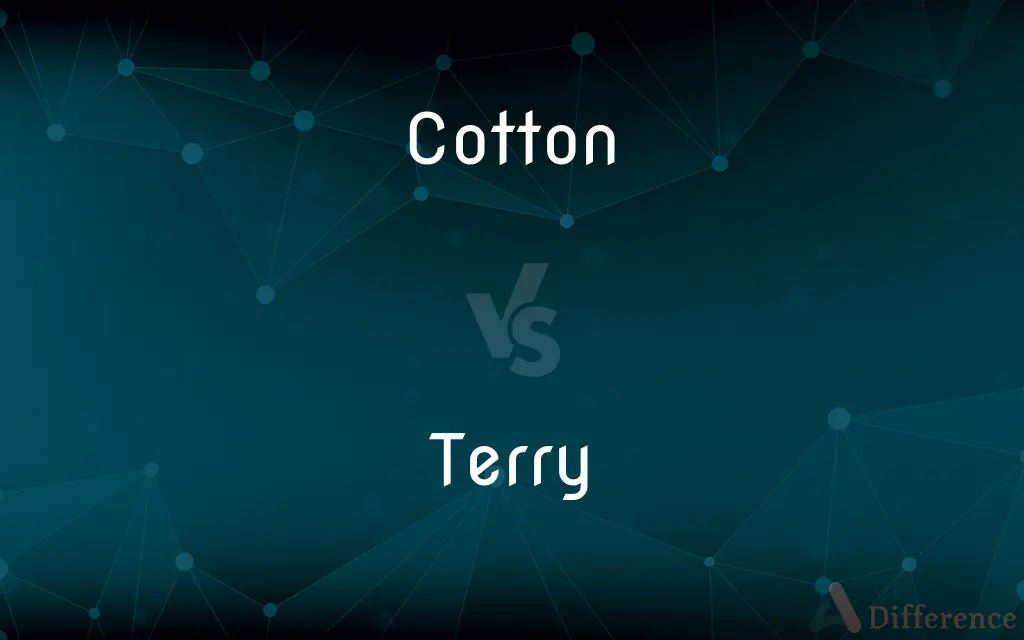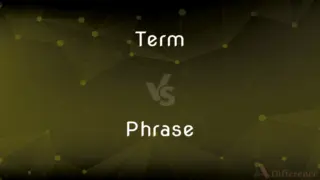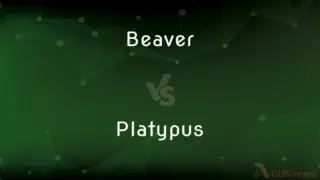Cotton vs. Terry — What's the Difference?
By Tayyaba Rehman & Urooj Arif — Updated on May 3, 2024
Cotton is a natural, soft fiber used extensively in textiles, while terry is a fabric style known for its looped pile, often made from cotton or blends.

Difference Between Cotton and Terry
Table of Contents
ADVERTISEMENT
Key Differences
Cotton, derived from the cotton plant, is a staple textile fiber globally known for its softness and breathability. In contrast, terry refers specifically to a weaving technique that creates loops on the fabric surface, enhancing its absorbency. This makes terry popular for items like towels and bathrobes.
Cotton is celebrated for its versatility and is used in a wide range of products from clothing to bed linens. On the other hand, terry fabric is specially designed for maximum absorbency and plushness, making it ideal for bath and kitchen products.
While cotton fibers can be woven or knit into various types of fabrics including denim, jersey, and chambray, terry is usually manufactured using a specific loop formation technique on a loom, which can be made from purely cotton or a blend of materials.
Cotton fabrics are often chosen for their lightweight and comfortable qualities, suitable for clothing that requires breathability. Whereas terry fabric, due to its looped pile, is thicker and more suited to products that need to withstand frequent wetting and drying.
Cotton's environmental impact varies, as it requires significant amounts of water and pesticides for cultivation. Terry fabric, depending on its material composition, might share similar environmental concerns, especially if made predominantly from cotton.
ADVERTISEMENT
Comparison Chart
Material Origin
Natural fiber from cotton plant
Fabric weave with looped pile
Common Uses
Clothing, bed linens, underwear
Towels, bathrobes, cleaning cloths
Texture
Soft, can vary in thickness
Thicker, plush due to loops
Absorbency
Moderate, depends on weave
High, due to looped surface
Environmental Impact
High water and pesticide use
Varies, high if mostly cotton
Compare with Definitions
Cotton
A soft, fluffy staple fiber widely used in the textile industry.
Cotton fabrics are preferred for baby clothes because they are gentle on the skin.
Terry
A weaving style that features loops and piles on one or both sides of the fabric.
Terry cloth robes are popular in spas for their high absorbency.
Cotton
A natural fiber that grows around the seeds of cotton plants.
The cotton t-shirt is perfect for hot weather due to its breathability.
Terry
Known for its thick, plush texture, often used in premium bath products.
The terry bathmat provided a soft landing out of the bath.
Cotton
Known for its ability to absorb moisture, making it a popular choice in warm climates.
Cotton towels are great for the beach as they quickly absorb water.
Terry
Fabric often made from cotton or a cotton blend, designed to absorb large amounts of water.
Terry towels are essential in any bathroom for drying off after a shower.
Cotton
Cotton fabric is versatile and used in a variety of clothing and household items.
She chose cotton curtains for their natural look and feel.
Terry
Its looped surface makes it ideal for cleaning cloths and mops.
Terry cloth rags absorb spills quickly, making cleanup a breeze.
Cotton
The fiber that is most commonly used to make breathable textile products.
Cotton socks are ideal for keeping feet dry and comfortable.
Terry
Particularly used for items where absorbency and softness are critical.
Terry cloth nappies are a durable, absorbent option for babies.
Cotton
Cotton is a soft, fluffy staple fiber that grows in a boll, or protective case, around the seeds of the cotton plants of the genus Gossypium in the mallow family Malvaceae. The fiber is almost pure cellulose.
Terry
Terry is both a masculine and feminine given name, derived directly from French Thierry and eventually from Theodoric. It can also be used as a diminutive nickname for the given names Teresa or Theresa (feminine) or Terence or Lefteris (masculine).
Cotton
Any of various shrubby plants of the genus Gossypium, having showy flowers and grown for the soft white downy fibers surrounding oil-rich seeds.
Terry
One of the uncut loops that form the pile of a fabric.
Cotton
The fiber of any of these plants, used in making textiles and other products.
Terry
A pile fabric, usually woven of cotton, with uncut loops on one or both sides, used for bath towels and robes. Also called terry cloth.
Cotton
Thread or cloth manufactured from the fiber of these plants.
Terry
A type of coarse cotton fabric covered in many small raised loops that is used to make towels, bathrobes and some types of nappy/diaper.
Cotton
Any of various soft downy substances produced by other plants, as on the seeds of a cottonwood.
Terry
A kind of heavy colored fabric, either all silk, or silk and worsted, or silk and cotton, often called terry velvet, used for upholstery and trimmings.
Cotton
To take a liking; attempt to be friendly
A dog that didn't cotton to strangers.
An administration that will cotton up to the most repressive of regimes.
Terry
English actress (1847-1928)
Cotton
To come to understand. Often used with to or onto
"The German bosses ... never cottoned to such changes" (N.R. Kleinfield).
Terry
A pile fabric (usually cotton) with uncut loops on both sides; used to make bath towels and bath robes
Cotton
Gossypium, a genus of plant used as a source of cotton fiber.
Cotton
Any plant that encases its seed in a thin fiber that is harvested and used as a fabric or cloth.
Cotton
Any fiber similar in appearance and use to Gossypium fiber.
Cotton
(textiles) The textile made from the fiber harvested from a cotton plant, especially Gossypium.
Cotton
(countable) An item of clothing made from cotton.
Cotton
Made of cotton.
Cotton
(transitive) To provide with cotton.
Cotton
To supply with a cotton wick.
Cotton
To fill with a wad of cotton.
Cotton
(horticulture) To wrap with a protective layer of cotton fabric.
Cotton
To cover walls with fabric.
Cotton
(tar and cotton) To cover with cotton bolls over a layer of tar (analogous to tar and feather )
Cotton
To make or become cotton-like
Cotton
To raise a nap, providing with a soft, cottony texture.
Cotton
To develop a porous, cottony texture.
Cotton
To give the appearance of being dotted with cotton balls.
Cotton
To enshroud with a layer of whiteness.
Cotton
To protect from harsh stimuli, coddle, or muffle.
Cotton
To rub or burnish with cotton.
Cotton
To get on with someone or something; to have a good relationship with someone.
Cotton
A soft, downy substance, resembling fine wool, consisting of the unicellular twisted hairs which grow on the seeds of the cotton plant. Long-staple cotton has a fiber sometimes almost two inches long; short-staple, from two thirds of an inch to an inch and a half.
Cotton
The cotton plant. See Cotten plant, below.
Cotton
Cloth made of cotton.
Cotton
To rise with a regular nap, as cloth does.
It cottons well; it can not choose but bearA pretty nap.
Cotton
To go on prosperously; to succeed.
New, Hephestion, does not this matter cotton as I would?
Cotton
To unite; to agree; to make friends; - usually followed by with.
A quarrel will end in one of you being turned off, in which case it will not be easy to cotton with another.
Didst see, Frank, how the old goldsmith cottoned in with his beggarly companion?
Cotton
To take a liking to; to stick to one as cotton; - used with to.
Cotton
Silky fibers from cotton plants in their raw state
Cotton
Fabric woven from cotton fibers
Cotton
Erect bushy mallow plant or small tree bearing bolls containing seeds with many long hairy fibers
Cotton
Thread made of cotton fibers
Cotton
Take a liking to;
Cotton to something
Common Curiosities
What defines terry fabric?
Terry fabric is defined by its looped pile surface which enhances its ability to absorb moisture.
Are all terry fabrics made from cotton?
Not all; terry can also be made from polyester, bamboo, or blends, but cotton is the most common material.
What is cotton?
Cotton is a natural fiber obtained from the seeds of the cotton plant, used extensively in the textile industry.
Can cotton be used for towels like terry?
Yes, cotton can be woven into terry cloth, making it suitable for towels and other absorbent products.
Why is terry considered ideal for bath products?
Its looped pile structure makes it very absorbent and soft, perfect for drying off and warming up.
What are the benefits of terry cloth in cleaning products?
The loops increase surface area, making it more effective at mopping up liquids and catching dirt.
Does cotton have any synthetic alternatives?
Yes, synthetic fibers like polyester are often used as an alternative to cotton due to their durability and lower water requirements.
Can terry fabric be lightweight?
It is generally thicker due to its loops but can be made lighter depending on the fiber blend and loop density.
What are the environmental impacts of using cotton?
Cotton cultivation can be resource-intensive, requiring a lot of water and pesticides.
Is terry fabric good for summer clothing?
Terry fabric is generally too thick and plush for summer wear; it's better suited for towels and robes.
How is terry fabric produced?
It is woven on looms that insert extra yarn loops into the weave, creating its characteristic pile.
What are common uses of cotton fabric?
Cotton is used for a wide range of products including clothing, bed linens, and medical supplies.
What makes cotton a popular choice for clothing?
Its softness, breathability, and natural origin make it comfortable and favored for all types of apparel.
How does the absorbency of cotton compare to terry?
Terry is typically more absorbent than plain cotton fabrics due to its looped construction.
What should be considered when choosing between cotton and terry for a product?
Consider the product's required absorbency, softness, and environmental impact.
Share Your Discovery

Previous Comparison
Term vs. Phrase
Next Comparison
Beaver vs. PlatypusAuthor Spotlight
Written by
Tayyaba RehmanTayyaba Rehman is a distinguished writer, currently serving as a primary contributor to askdifference.com. As a researcher in semantics and etymology, Tayyaba's passion for the complexity of languages and their distinctions has found a perfect home on the platform. Tayyaba delves into the intricacies of language, distinguishing between commonly confused words and phrases, thereby providing clarity for readers worldwide.
Co-written by
Urooj ArifUrooj is a skilled content writer at Ask Difference, known for her exceptional ability to simplify complex topics into engaging and informative content. With a passion for research and a flair for clear, concise writing, she consistently delivers articles that resonate with our diverse audience.
















































